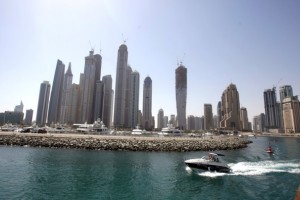By Anne Applebaum www.washingtonpost.com
Dubai. Foreigners visiting New York or Chicago in the 19th century often came away with conflicting feelings. Some found American cities ugly by comparison to their European counterparts: They seemed vulgar, blatantly commercial, lacking in taste. The natives had higher living standards but they were crude, and the ethnic mix — German, Irish, Italian, Jewish — was terrifying.

A few sensed that there might be something in this new civilization worth admiring. “It is an absorbing thing to watch the process of world-making, both the formation of the natural and the conventional world,” an English traveler, Harriet Martineau, wrote in 1837: “I witnessed both in America; and when I look back upon it now, it seems as if I had been in another planet.”
I thought about those old visions of urban America while strolling not long ago through the Marina, a neighborhood in “new” Dubai (as opposed to “old” Dubai, mostly constructed in the 1970s). The architects were hired in 1999, and the first phase was finished in 2004; soon, the Marina will contain 120,000 people, along with hotels, restaurants, yacht moorings, shopping malls and canals, meant to remind visitors of Venice. It might go bankrupt — it has once already; Dubai is plagued by real estate bubbles — but dozens of brand-new skyscrapers, some still with their scaffolding around them, are nevertheless pushing upward around the Persian Gulf.
The Marina, to a jaded American eye, is incurably vulgar. So is the rest of the city. There is almost no evidence of history or local culture. International brand names, from Applebees to Rolex, are plastered everywhere. Everything is imported, from the raw fish at Nobu to the coffee at Starbucks. In Abu Dhabi, the emirate down the road, they’ve bought the names “Louvre” and “Guggenheim” and are constructing museums to match. I am instinctively appalled — how can you buy the Louvre? — but perhaps visiting Europeans once felt the same way about Henry Frick’s New York mansion and the Old Masters within it.
The architecture is ersatz, too. Sometimes there are local elements — the odd Arabian Nights turret, a fake souk — but the tallest building in the world, the Burj Khalifa, distinctly resembles Chicago’s Willis Tower (which also used to be the tallest building in the world). This is no accident: Both buildings were designed by Skidmore, Owings and Merrill, also from Chicago. If the fountains around the Burj Khalifa (illuminated by 6,600 lights at night) seem like something out of Las Vegas, that’s no accident either: They were designed by the same company that built the fountains at the Bellagio hotel and casino.
Just as some Europeans were offended by 19th-century America, I was stunned by the wealth of Dubai’s inhabitants and visitors: Someone must be buying all those Rolexes and staying in the executive suites at the Armani Hotel. I am also intrigued by the ethnic mix. Indian, Nigerian, Japanese, British, Russian, Filipino and Australian sunbathers mix with the occasional Emirati in a white headdress on the Marina’s beaches. Women in bikinis walk by women in burqas. Everyone talks on cellphones.
Yet this apparently harmonious, multiethnic society has a dark side. Occasionally, the invisible Arab police state arrests a tourist for an alleged indecent gesture or deports somebody without explanation. Nobody protests, because almost nobody “lives” in Dubai, in the sense that a 19th-century immigrant actually lived in New York. Less than 20 percent of Dubai’s 1.7 million inhabitants are citizens: The rest are ex-pat bankers and traders — there is no income tax in Dubai — or low-wage laborers, mostly from South Asia, some of whom live like indentured servants.
No wonder they aren’t bothered by the vulgarity of the place: They’re probably going to move somewhere else next year anyway. And a transient population isn’t likely to launch a movement for democracy or political rights. If they protest, they risk expulsion. The natives aren’t excited about the prospect of majority rule either, since the majority is foreign. That’s why you’ve heard nothing about Dubai since the start of the Arab Spring.
Similarly to 19th-century Europeans’ thoughts about America, I resist the idea that Dubai heralds the civilization of the future. But I have to concede that in some senses it might. Not only Singapore and Hong Kong but parts of central London, now populated by transient bankers and their semi-legal Filipino servants, have more in common with Dubai than with their own hinterlands, even if the architecture is different. I can also see how Dubai, which is clean, law-abiding and well-run, might seem like a haven if one were coming from a messy, violent society such as Pakistan or even Russia.
To me it seems stultifying, as well as strange: Like Harriet Martineau, I feel as if I had been in another planet. Yet there have always been people who dream of escaping their culture, who long to forget their history and who are content to live without the past. Now, in Dubai, they can.












